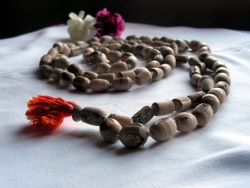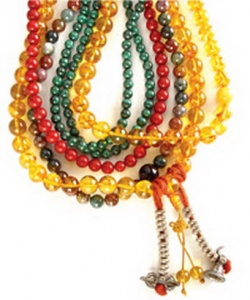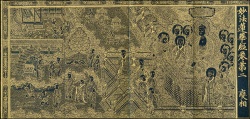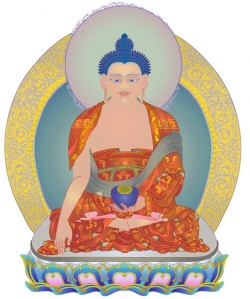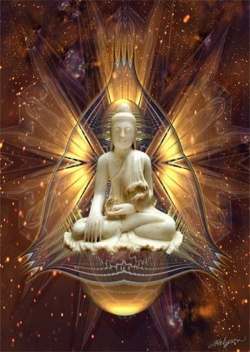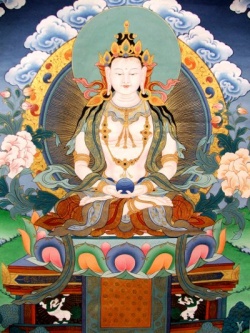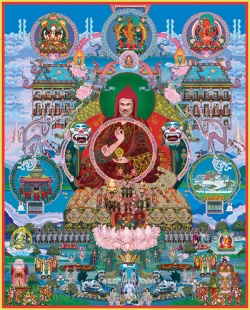Malas - prayer beads
Buddhist malas are used at a basic level for counting mantras, but the materials used and the number of beads have acquired meanings as their use has evolved. There is a nice book entitled 'Beads of Faith' (authors Henry & Marriott) which charts the use of rosaries across all faiths, and of course our own Robert Beer who offers some insight into Tibetan usage:
I am not at all shy to admit that the Buddhist mala derived from the Hindu 'japa mala' and that the meanings ascribed to 108 beads have been adapted for our needs. There are also superstitions - use only the left hand, the ring finger or the index finger and thumb. (A Hindu would be horrified - they use the right hand as the left is used for 'toilet' functions.)
Most monks I have spoken to (mainly Tibetan) have a simple wooden or seed mala with no markers or decoration, and advise that either hand will do and the superstition of not crossing the guru bead is all tosh. 108 beads mean that we have 100 plus 8 to account for mistakes. Tibetans also use their mala for blessing others, as it is believed the mala absorbs great power through deity mantra practice.
Some, I believe, have a 'public' mala, but use another in private for Tantra, when the numbers and usage become much more complex and meaningful than originally indicated by the monks.
They will cover a mala when in use for mantra recitation.
Maybe this is a cultural habit from India. Hindu monk will use the mala inside a mala bag when in public, which prevents others seeing it - there is quite an emphasis on seeing as the principal way of engaging with a deity and the 'evil eye' is prevented from affecting a hidden mala.
I have tried several different materials because I felt 'drawn to them'. Fancy lapis with heavy carved gemstone dorje dangling and tinkling as a bell, huge seed malas which would be more at home around the neck of a Saddhu (or 2), and weird materials such as fossil coral.
Some practitioners use Lapis for Medicine Buddha, Carnelian for Vajrayogini, Bone for wrathful practices etc. - a different one for each deity. The colour of the deity is matched by the gemstone, in general.
Others believe that as the mala may be part of an 'offering' (for example as part of a mandala) they should be of the best material we can afford.
With many hundreds of thousands of mantras to count, in the end simple and lightweight seems best, so I have strung a few of my own using small bodhiseed, green sandalwood (scented), and ebony - with gemstone markers. I have found doubled -up nylon thread is best, sometimes with a single very thin fishing monofilament as a backup in case of breakage, with knots superglued, and with a stainless steel ring at the bottom, instead of a tassel, for me to attach whatever I want.
I have give away many malas as I have experimented and have no 'attachment' to them, but find the use of them interesting.
The method of blessing I have been taught involves placing the mala in the right palm, placing the left hand on top (so cupping the mala) silently reciting the Yidam's mantra 3 or 7 times and then blowing on the mala 3 times. When finished with, the same is done.
I oil wooden or seed malas (patchouli and lavender) but not gemstones. Some gemstones are quite fragile; lapis, for example, can be harmed by sweat and water, so is not a good one to wear all the time. If there is a risk of dampness (of any sort) I keep gemstone malas in a waterproof pouch on my belt or in my pocket. Some oils may have chemicals which affect gemstones, but I'm not sure. I do spray any new wood or seed mala with fabric waterproofer to protect the string and bead, then oil afterwards.
There is a special demand for bone malas made from the skulls of dead monks. I believe there to be a lot of fake malas of this type on the net. The Chinese (including Hong Kong) also may call any blue mala 'lapis', for example, and pretend they are unaware that it is a specific material. There are also many fake gemstones in use. Gems described as 'moonstone' may in fact be opalite (glass), and most dzi beads are the result of laboratory chemistry and cookery rather than nature. Caveat emptor. ;)
Methods of stringing vary as well. Three strands (or another significant number) tends to be recommended in Tibetan malas, but most I've seen are on a bit of rough waxed string, maybe some made from Yak wool or simply cotton. In India malas tend to be knotted between the beads (a Hindu preference for beads not to touch each other). In China, the trend seems to be a single piece of strong thread.
There is a practical consideration. In group work the sound of gemstones clicking may be distracting. Easily resolved - use a wooden or seed mala, or string the gemstone mala so that it may be tightened a little to avoid noise.
When dealing with Bodhiseed or bone, 5 or 9 threads is possible, especially if twisted into one string and waxed beforehand, as the holes drilled in the beads tend to be large. With gemstones I rarely find the holes large enough to take more than 3.
Some shapes are easier to use than others I find. Doughnut shaped beads (say 8x6 mm) are easy to move and allow the mala to be shorter than if using round beads (of say 8mm). This means a full mala can be easily kept off the ground during prostrations or when seated on the floor.
Aside from the various meanings ascribed to the beads and threads, practical considerations are also important. I've found (no surprise) that good quality costs more and that good maintenance (restringing, cleaning, oiling) is very important. But even more important is its place in the relationship with the guru, who may have given the mala to you or blessed it, and that can be priceless.
Apparently they are also used in Zen and in the Theravada:
http://dic.academic.ru/dic.nsf/enwiki/754783
quoted by Gyatrul Rinpoche in "The Generation Stage in Buddhist Tantra (with thanks to Dorje):
Padmasambhava, says: "The best type of mala to use to increase the number of recitations is a mala made from some type of precious jewel (Tib. Tin O che). A mediocre type of mala is made from the seed of a tree or fruit, and inferior type of mala is made from wood, earth, stone or medicine."
A mala made from seashells, earth, wood or seeds from trees or fruit is meant to be used to accomplish peaceful sadhanas and peaceful action. A mala made from gold will accomplish expanÂsive karmas. A red coral mala is best for accomplishing powerful sadhanas. A steel or turquoise mala is good for wrathful activity. A mala made from dzi or other precious stones can be used to accomÂplish any of the karmic activities you are doing.
A mala made from apricot stones will accomplish expansive acÂtivity. A mala made from "lot ton" (a tiny, round black seed within a fruit) accomplishes powerful activity A mala made from raksha beads accomplishes wrathful practices. A mala made from bodhi seeds accomplishes all dharmas. Malas of bodhi tree wood accomÂplish peaceful karmas. A mala of mulberry beads accomplishes powerful karmas. Malas of mahogany wood accomplish wrathful practices. Malas made of ivory, especially from an elephant's tusk, will accomplish all concerned activity.
Beads made of stone are good for expansive practice. Beads made of medicine are good for wrathful practice. Malas with many different types of jewels are good for any practice. However, I sugÂgest that you not attempt to create a mala with a lot of different beads on it because, unless you know which combinations are efÂfective, you may cause a non-positive result.
Next, the text mentions the different kinds of benefits that are derived from using different types of malas. An iron or steel mala multiplies the virtue that is accumulated with each recitation in a general way. A copper mala multiplies each recitation four times. A raksha mala multiplies each recitaÂtion by 20 million, and a pearl mala by 100 million. A silver mala multiplies by 100,000 and a ruby mala by 100 million. A bodhi seed mala manifests limitless benefits for any form of practice, be it peaceful, expansive, powerful or wrathful.
You should all know the mala's meaning and the best way to string it. String your mala using three, five or nine strings, and no other number. Three strings symbolize the three kayas, five strings symbolize the five buddhas, and the nine strings symbolize the nine vehicles.
The main guru bead may be composed of three beads, symbolÂizing the three vajra states of being, the three kayas. The smallest bead on the outside should be blue, perhaps made of lapis. The color blue symbolizes the unchanging mind of ultimate truth. The bead in the middle should be red, to symbolize vajra speech, and the innermost bead should be white, to symbolize the vajra body.
Your mala must be blessed by a lama, and you should constantly bless your mala yourself by imbuing it with energy. You must put energy into your mala before counting recitations with it, to proÂduce real benefit.
You should clean your mouth and hand, and then your mala, before using it. You may also scent it with sandalwood oil.
Next, generate yourself as the deity, place the mala in your left hand and arrange the beads with the guru bead placed vertically in the center. Recite the mantra that transforms all dharmas into the awareness of their true nature: OM SWABAVA SHUDDO SARVA DHARMA SWABAVA SHUDDO HAM. This mantra cleanses and transforms impure perceptions into the awareness of emptiness.
From emptiness, the guru bead appears as the central deity in the mandala, and the other beads appear as the members of the entourage. This part of the practice is the meditation upon the samayasattva. Next, invoke the jnanasattva. Invite the primordial wisdom beings to come forth, hooking them so that they dissolve into the samayasattva, just as you would in a sadhana. Invite the wisdom beings to come from their pure lands into the space in front of you. They then dissolve into your mala and remain firm there. Thus, every part of your mala is the entire mandala. This includes the central deity, entourage, lotus seats, ornaments, hand emblems, colors, etc. Blessing your mala in this way multiplies each syllable of whatever mantra you then recite 100,000 times, besides causing good karmic results. Therefore, it is extremely important to do this.
Your mala represents not only the form of the deity but the speech of the deity as well. For example, if you recite the One-HundredÂSyllable mantra, the guru bead represents the syllable OM and the other beads represent the remaining syllables.
Guru Padmasambhava said, "Whenever you recite peaceful mantras, use the tip of your thumb to count the mala. When recitÂing expansive mantras, use the third finger. Use the ring finger and thumb when reciting powerful mantras, and use the little finÂger when reciting wrathful mantras." Use only your left hand to count mantras. The right hand is but rarely used; for instance, in some wrathful practices. Some books teach the use of both hands, but do not use the right hand only.
Whatever kind of practice you are doing, whether peaceful, wrathful, powerful or expansive, always be aware that the thumb is a vajra hook which hooks spiritual powers, deities and other blessings. It is also easy to move the beads with your thumb.
The text does not elaborate, but there are some extensive teachÂings on how to move the beads on the malas when performing certain practices. In some wrathful practices, you jerk the beads with both hands and so forth. The following teachings, which explain how to care for your mala when you are not using it, come straight from the mouth of Guru Padmasambhava. If your mala has been repeatedly blessed by great lamas, by your own teacher and by yourself as part of your deity practice, it should accompany you like your shadow. You keep the root samaya of the vajra mala by never letting it leave your body.
I'm interested to know who else uses one and if materials etc play a part in choosing one.
How do you regard yours - precious, holy - or just a string of counting beads! ;)
